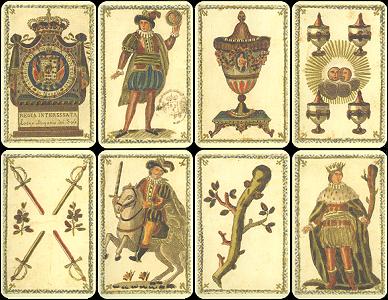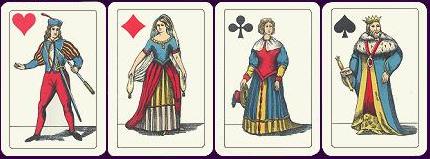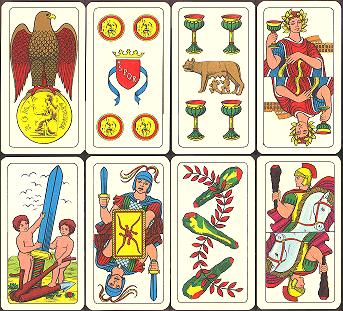Italian playing cards have a very old tradition, which is reflected by the large number of regional patterns still in use in the country. Besides the extant designs, and a few more that turned obsolete in time, Italy is also the homeland of the tarot, whose parallel history led to develop regional varieties, as well. This gives reason for the largest selection of traditional playing cards found in any country of the Western world.
Playing cards first reached Italy sometime around the late 1300s. By that time, the Arabic populations of northern Africa and the Near East already knew card games; little doubt exists that this is where playing cards came from. It is not known whether playing cards reached Italy form the south or from the north; the Arabic world exerted a strong cultural influence on the southermost Italian regions, while the rich cities of northern Italy, particularly Venice, ran busy trades with the Arabs. Playing cards (or 'Saracen cards', as they are mentioned for the first time in a late 14th century chronicle) may have followed either of the two directions. It did not take a long time before the successful pastime had spread throughout the country.

ace of Coins from
an archaic Latin-suited deck
of uncertain origin, c.1400
|
In those days, the standard deck already consisted of 52 cards, divided into four suits marked by Coins, Cups, Swords and Sticks. While in southern Italy the structure of the deck remained virtually unchanged, in the northern regions, no more than half a century later, a number of illustrated cards featuring allegories were added to the standard ones, thus giving birth to the tarot. This new deck was used mostly by the upper class, for two main reasons; in first place, the additional allegories and their ranking criterion required a good level of knowledge to be understood, and the cultured players represented a very restricted élite. In second place, the price of these decks, some of which were hand-painted by artists, was out of reach for the large majority of the common people, who could only afford the standard 52-card decks. |
An interesting change that both the tarot and the standard playing cards developed concerns the last three subjects of each suits, i.e. the court cards, which no longer bore a written name, as they did in the Arabic decks, but featured human figures: in the south of Italy they were a knave, a cavalier and a king; in the tarot also a female personage, the queen, was added to the aforesaid three personages.
The standard deck and the tarot underwent an almost parallel evolution. The former, which the lower social class played with most, in many areas dropped the 8s, the 9s and the 10s, so only 40 cards were left out of the original 52. Curiously, a pattern with very similar features was also used in Portugal (but not in Spain, where a local design had developed). The design of such Italo-Portuguese cards, found in the whole southern half of Italy, up to Rome, maintained some original elements, such as the old arrangement of the suit pips. Instead in the north, the same suits were redesigned in order to fit the local taste and tradition. |

5 of Batons with
Arabic-derived polo sticks,
from the same archaic deck
|
Meanwhile, also the additional allegory cards of the tarot, yet slightly differing in subject and rank from one place to another, developed into a steady scheme. Already by the late 1400s three main tarot patterns could be told: one in the area of Milan, one in the area of Bologna, and one in the area of Ferrara and Venice. The latter died out very soon, during the 16th century.
Also the one in Milan would have probably been bound to die out, had the French occupants not exported this pattern to their own country, where the tarot set new roots. But about 400 years later, by the turn of the 19th century the same kind of deck, with some inevitable changes to the old design, came back to north-western Italy, and revived the players' interest, developing again into standard local patterns (Lombardic, Piedmontese).
The tarot scheme devised in Bologna was the most successful in Italy. It survived with few changes up to our present age; it is one of the three regional tarots still in production. Sometime during the 17th century it also inspired a new special variety of tarot called
Minchiate, with many more additional allegories (97 cards all together), which spread towards Florence, then towards Rome, and probably reached much farther regions. The
Minchiate too died out within about one century, except in Tuscany, where the last specimens were manufactured in the early years of the 20th century.
Furthermore, the tarot of Bologna somehow influenced also the one used in Sicily since the 18th century: the latter has a few peculiar mismatching features, but its structure shares several elements with the aforesaid tarot, which are consistent with such distant origin.
From the 1600s onwards, the Spanish administration of the southern Italian regions exerted its influence also on playing cards: the old Italo-Portuguese pattern gradually disappeared, replaced by decks of clear Spanish influence; their structure was the same, but their designs somewhat differed.
Also most of the central parts of Italy became acquainted with the Spanish pattern, particularly the lands under the Papal State, whom the Spanish had always been in good relations with.
This situation remained unchanged for about two centuries: between the late 1700s and the turn of the following century, when the many lands under foreign administration gradually began to gain independence, some local patterns, still clearly inspired by the old Spanish cards, were established in different parts of central and southern Italy. |

a Spanish-like pattern dating back to the 1820s, printed in Naples,
likely an ancestor of most patterns of the southern group |

Piacentine pattern, 19th century edition by Lamperti
(this specimn is a modern replica by Modiano) |
In the city of Piacenza, under French administration, a fifth pattern, presently called Piacentine, was developed from the special deck used by the occupant soldiers to play Aluette, a Spanish-suited deck. In the island of Sardinia, located midway between Italy and Spain, a special design created by a manufacturer of Barcelona became the local regional pattern.
In north-eastern Italy, the old Latin-suited designs that had been used for the local tarots were also adopted for standard decks, giving origin to five different patterns, some of which still today maintain a double version, with either 40 or 52 cards. |
Instead the north-western parts of Italy, more subject to a French cultural influence, switched to Hearts, Diamonds, Clubs and Spades, yet with a different pattern in each region.
Finally, when after WW I the southern part of Tirol was annexed to Italy, the German-speaking population never gave up the region's traditional pattern, whose suits are Hearts, Acorns, Bells and Leaves; an Italian version was then created, identical to the original Austrian one, whose name, after the city of Salzburg, was also maintained. Today Italian Salzburger decks contain 40 cards. |

old Toscane pattern by Viassone (Italy); this design was replaced
in the mid 1900s by shrinking the Fiorentine pattern |
Only in very recent years, the traditional number of 36 cards (i.e. each suit starting with a 6) has been increased by adding 5s to each suit, thus marking a slight difference with Austrian editions, whose number of cards has remained as usual.

the modern and already extinct Romane pattern
(by Capitol, Italy): some Coins show the Mouth of Truth,
the ace of Swords features the legendary founders of Rome,
Romulus and Remus, and characters wear roman robes |
The Toscane cards too used to be different from what they are now:
their pattern could be easily told from the Fiorentine cards, Florence's own design, larger and richer in details,
used in the same Tuscan region. But as of the second half of the 20th century Fiorentine cards reduced in size and with less accurate details began to be manufactured under the name Toscane, so the true Toscane pattern disappeared.
Also the Romane cards, created around 1970, in the
attempt of giving the city of Rome its own pattern, had no better luck; they were produced
in a rather limited number of decks by a minor manufacturer (Capitol), but they encountered very little
favour by card players, again due to the greater popularity of the Piacentine, and
during the early 1980s their production was completely discontinued.
|
In the following pages each pattern is listed in alphabetical order, with a brief
explanation of its main characteristics.
page 1
regional patterns - part I |
page 3
regional patterns - part III |
page 4
regional patterns - part IV |
page 5
fancy patterns |
OTHER GALLERIES






















or back to

INTRODUCTION
AND HISTORY
|

MULTI-LANGUAGE
GLOSSARY |

THE FOOL &
THE JOKER |

INDEX
TABLE |

REGIONAL
GAMES |

PLAYING CARD
LINKS |